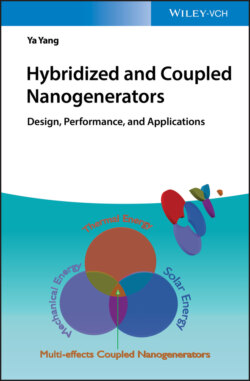Читать книгу Hybridized and Coupled Nanogenerators - Ya Yang - Страница 18
1.4 Applications
ОглавлениеHybridized nanogenerators have extensive practical applications in environmental energies scavenging technologies and self‐powered sensor networks. Wind and solar energies can be simultaneously scavenged by the hybridized nanogenerators, consisting of TENGs and Si‐based solar cells. Moreover, the sizes of the hybridized nanogenerators can range from centimeters to hundreds of meters for harvesting large‐scale energies, pushing the potential applications of the hybridized nanogenerators instead of the conventional wind–solar energy harvesters in some environments. Moreover, the energy conversion efficiency is still a challenge for these energy scavenging devices. The stability of these hybridized nanogenerators in the natural environment still needs to be considered. Hybridized nanogenerators have been used as various self‐powered sensors, where the different nanogenerators can detect the different physical signals to realize simultaneous detection. Because different nanogenerators were used for detecting the different physical signals, no signal interference can be found in the detection process.
The coupled nanogenerators have potential applications in multi‐energies scavenging and multifunctional sensor systems. The core of the coupled nanogenerators is the multifunctional material; therefore, looking for a high‐performance material is one of the most important challenges for the applications. Ferroelectric materials‐based coupled nanogenerators have demonstrated the ability of scavenging multi‐energies from the environment, indicating that the coupled nanogenerators have better performances than individual energy scavenging devices. However, energy conversion efficiency of these devices still needs to be enhanced. Ways to obtain more electricity from these devices also need to be considered. For the application of multifunctional sensor systems, coupled nanogenerators exhibit more advantages than the conventional methods of integrating the different sensors in a system, such as smaller sizes, higher resolutions, and lower cost. The coupling effect among the different physical signals is very interesting due to the possible new mechanism. However, how to change the current/voltage in one circuit by the coupling needs to be investigated to quantify these signals in the multifunctional sensing process.
The hybridized nanogenerators have more chances to be used as a practical large‐scale energy scavenging technique as compared with the coupled nanogenerators. However, the coupled nanogenerators have more scientific significance than the hybridized nanogenerators, where the coupling enhancement among the different physical signals is interesting for future research.
